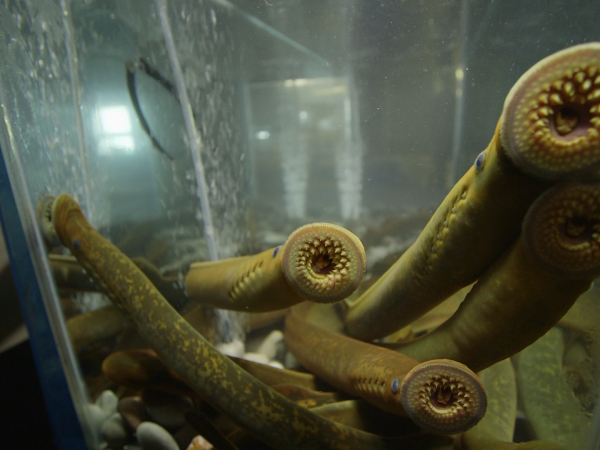
The long, fast, toothy muskellunge (also known as muskie or musky) is nicknamed the “Fish of 10,000 Casts” due to its notoriously elusive nature. It is the apex predator in all waters where it’s found, known to hide in underwater cover, aggressively ambushing prey. They eat fish almost exclusively, though they have been known to consume just about anything they can swallow including birds, small mammals, and their own kind.
“A lot of people think these fish aren’t very common and they’re very difficult to catch and generally live in pristine wilderness situations,” said Jordan Weeks, a Wisconsin Department of Natural Resources fisheries supervisor and a muskie expert. “But over the past 50 to 75 years propagation and stocking has really increased their population in Wisconsin and throughout the Midwest.”
The habits of anglers who pursue these giants—which can weigh 50 pounds or more—are also credited with their popularity and rising populations.
“A lot of it results from the passion of muskie anglers,” said Weeks. “As recent as the ‘80s, most that were caught were harvested. But fast forward to today and most people who keep them are non-muskie anglers. In fact, they’re not even nice to each other for instance if you catch one and it happens to die, they’ll reprimand you.”
Nowadays, folks targeting muskie are so focused on the welfare of the fish that some consider their clubs unofficial extensions of state agencies.
Nonprofits augment muskie programs
“They’ve been instrumental in distribution and creating new fisheries,” said Weeks of the state’s numerous muskie clubs. “Super-helpful financially and a benefit to the fish and biologists.”
Dave Allen is vice-president of the Musky Clubs Alliance of Wisconsin, a group of about 25 clubs whose members aim to improve the sport through a combination of conservation and cash.
“We try to help with everything,” he said. “For instance, where the techs or the DNR biologists didn’t have the equipment and it wasn’t in the budget, we said ‘Need and electroshocking boat? We’ll buy you one.’ And we established an endowment at University of Wisconsin – Stevens Point. It’s about $120,000 and will go on forever, for scholarships each year for students going into fisheries management.”
According to Allen, clubs conduct fundraising efforts throughout the year, often working on individual muskie-related projects. And he’s no stranger to individual projects, going on to detail how his father helped re-establish spotted muskie, a now-popular strain in Wisconsin, years ago with help from a friend who owned a small airplane.
“My dad had a vision to get these re-introduced so they flew over near Burt Lake in Michigan to get these eggs in 1989,” he explained, “and they brought them to the WDNR hatchery in Wild Rose, raising them there and every time the DNR needed food they reached out to my dad, who was with Dave’s Musky Club. The state wasn’t funding it, so we spent about $15,000 to feed them that year.”
Allen said that when they released the 12-inch fish, they were split between Long Lake and Green Bay in Lake Michigan. The club purchased food for the growing fish each year and the state provided a technician to feed and monitor them. But after a state budget cut a few years later, the club hired a technician and continued purchasing food rather than let the spotted muskie program go belly up. Until about 2008, he said, the state’s muskie clubs financed the production of 30,000 spotted muskie each year. For the best results in size and longevity, the fish required a pricey diet of live minnows of varying size throughout the rearing process.
Days of wall-mounted muskies are over
“We’ve got a lot of historical photos from back in the day where you might see 40 or 50 muskies hanging on a board and it’s impressive, but by today’s standards it’s not very good,” said Jim Francis, the Lake Erie Basin Coordinator for Michigan Department of Natural Resources. “I think it started with bass, the catch-and-release ethic, and when you talk about bass or muskies people are pretty rabid about catch-and-release—it’s definitely changed.”
In Michigan, anglers are allowed to keep one fish per year with certain minimum size limits and during certain months, he explained. Anyone who decides to keep a muskie must register it electronically with the state. Out of over 1.1 million licenses sold in the 2018-2019 season, 28 muskies were registered. Even that minuscule number prompts static from the muskie crowd, according to Francis.
“We do get some pushback from some clubs because they think it’s not a foolproof system,” said Francis. “So when they see one of these speared fish on social media (there is a limited spearing season) they’ll do everything they can to track it down and see if it was registered. They’ll send it to us and ask: ‘Hey, was this fish registered?’”
Francis said he believes the system is a good one that works and that, to his knowledge, no wildlife officer in Michigan has come across anyone possessing an unregistered muskie.
Like in Michigan, Allen said keeping a muskie in Wisconsin is rarely seen, though he admits he kept one about 15 years ago.
“Basically it got hooked bad, it was 38 inches, and it bled to death,” he explained. “I tried for more than an hour to revive it. I ran an aerator to get it fresh oxygenated water, I had it in a couple different places. The guy I fish with all the time he says, ‘The fish is dead! You can’t revive it.’”
They took the fish home and grilled it that night. Allen described it as delicious and said they still talk about keeping that fish, all these years later.
Muskie thriving even with surge in interest
“I can tell you there are more muskie anglers today than there have ever been and fishing is better than it’s ever been,” assured Weeks. “Plus we’re seeing more really large individuals captured than we’ve ever seen over the course of their range.”
Regardless of advances in electronics and the advent of trolling, where boats cover more water with multiple rods instead of casting one lure with one rod repeatedly, populations have surged in more than 20 states and three provinces where muskie are found.
“Despite any of these advances, it doesn’t negatively impact populations because muskie anglers don’t keep them. They stay for a long time, like 20 years, and are ‘recycled’ fairlyoften,” said Weeks.
While muskie methodology has changed, so has the cost for the newest, latest gear.
Weeks said artificial baits begin at $25 and go to $100, more for custom-painted art-like lures. Live bait isn’t penny ante, either.
“White suckers are the preferred bait and run anywhere from $11 to $20 per individual,” he said. “But once a fish grabs them, they’re toast.”
Allen said he doesn’t spend much on lures because people often give him lures, so maybe $30 is the max he’s spent on a single lure.
“Well, rods are a different story. If you get a good reel it’s $400-500, and a good rod $300-400. I have a stack of rods and I use about five of them,” said Weeks. “Do you really need all this fancy stuff? Probably not – just chuck a bucktail lure out there and drag it back and hopefully there’s a fish on it.”
Catch more news at Great Lakes Now:
I Speak for the Fish: Bringing muskie to the masses
Want a healthy walleye fishery? Stock some muskie
Featured image: Dan Kovalaske, an Ohio Department of Natural Resources fisheries coordinator, displays a just-landed musky on Alum Creek Reservoir. Photo by James Proffitt.
1 Comment
-
Good ‘ol muskies…elusive indeed. They can come out of nowhere and scare the heck out of you when they strike.




